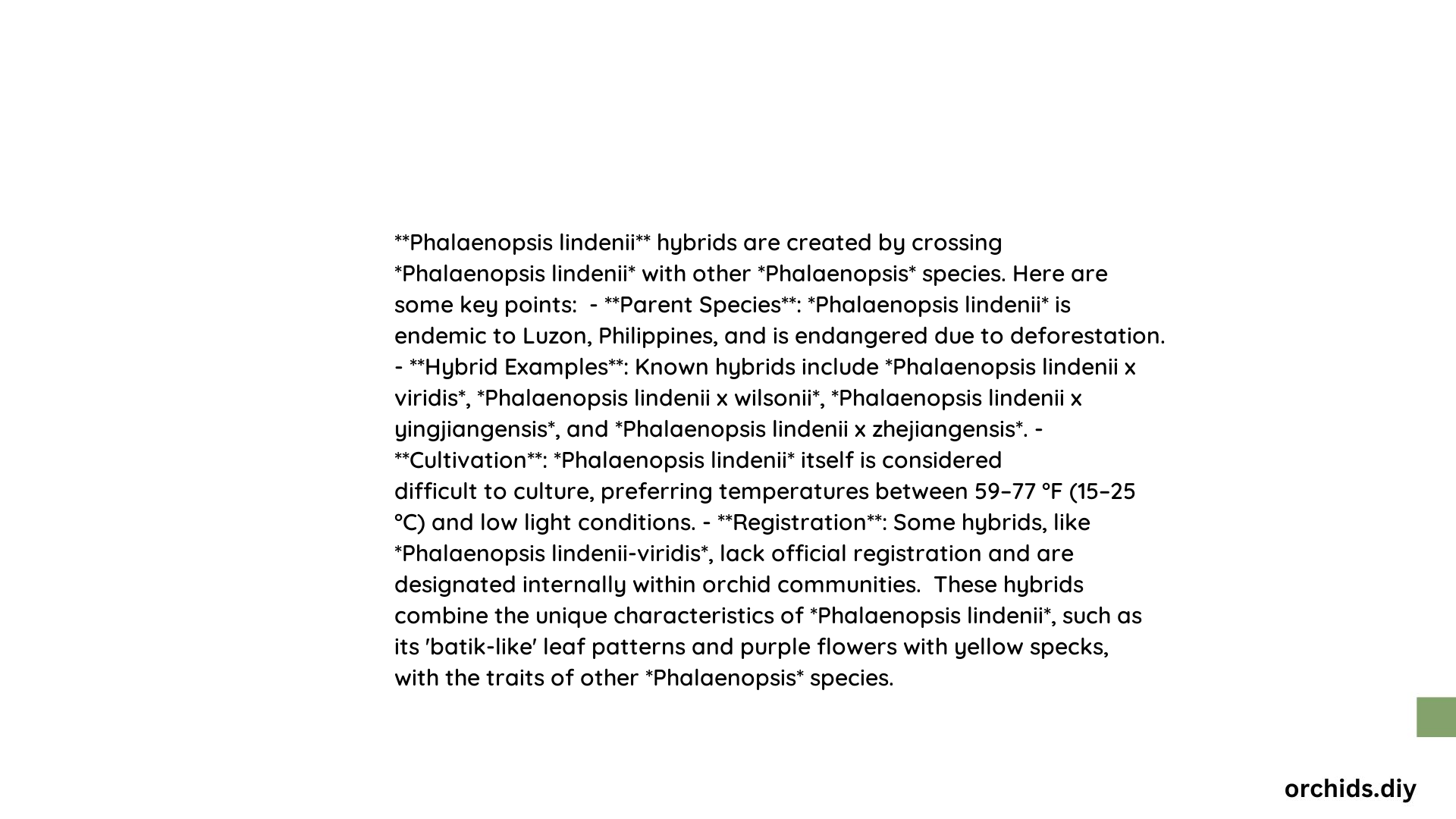The Phalaenopsis lindenii hybrid is a captivating orchid variety known for its elegant blooms and adaptability to indoor environments. This hybrid combines the best traits of its parent species, resulting in a plant that boasts stunning flowers and relatively easy care requirements. Phalaenopsis lindenii hybrids are prized for their long-lasting blooms, which can persist for several months under optimal conditions. These orchids are well-suited for both novice and experienced growers, making them a popular choice among orchid enthusiasts.
What are the Ideal Growing Conditions for Phalaenopsis lindenii Hybrid?
Temperature Requirements
Phalaenopsis lindenii hybrids thrive in moderate temperatures:
- Night temperatures: Above 65°F (18°C)
- Daytime temperatures: Between 75°F (24°C) and 85°F (29°C)
- Maximum tolerable temperature: Up to 90°F (32°C) with adequate humidity and air movement
Humidity Needs
Proper humidity is crucial for the health of Phalaenopsis lindenii hybrids:
- Ideal range: 50% to 80%
- Acceptable home environment: 40% to 50% with good air circulation
- Methods to increase humidity:
- Use a humidifier
- Place the plant on a pebble tray filled with water
- Group plants together to create a microclimate
Light Requirements
Phalaenopsis lindenii hybrids prefer bright, indirect light:
- Optimal light intensity: 1,000 to 1,500 foot-candles (10,000 to 16,000 lux)
- Best placement: East-facing window or shaded south/west windows
- Artificial lighting: Use sources emitting >10,000 lumens per square yard/meter, placed 1-2 feet above the plant
- Caution: Avoid direct sunlight to prevent leaf burn and overheating
How to Induce and Maintain Blooming in Phalaenopsis lindenii Hybrid?

Triggering Flower Spike Formation
To encourage blooming:
- Provide a period of cooler night temperatures (around 55°F or 13°C) for about two weeks in autumn
- Maintain consistent light and humidity levels during this period
- Continue regular care routines to support overall plant health
Extending the Blooming Period
To maximize bloom duration:
- Maintain stable environmental conditions
- Avoid sudden temperature or humidity fluctuations
- Provide appropriate watering and fertilization
- Remove spent blooms to encourage new flower production
Seasonal Care Adjustments
Adapt care routines according to seasons:
| Season | Care Adjustments |
|---|---|
| Winter | – Reduce watering frequency – Move to indirect sunlight – Protect from cold drafts |
| Summer | – Increase watering frequency – Provide additional humidity – Ensure adequate air circulation |
What are the Best Propagation Methods for Phalaenopsis lindenii Hybrid?
Keiki Propagation
Keikis are small plantlets that grow on the flower spike:
- Wait until the keiki develops its own roots and leaves (at least 2-3 inches long)
- Carefully cut the keiki from the mother plant using sterilized tools
- Pot the keiki in a well-draining orchid medium
- Maintain high humidity around the new plant until established
Meristem Culture
This advanced technique is typically used in commercial settings:
- Extract meristematic tissue from the mother plant under sterile conditions
- Culture the tissue in a specialized growth medium
- Develop plantlets in a controlled laboratory environment
- Acclimatize and transplant the resulting plants
How to Create the Optimal Potting Environment for Phalaenopsis lindenii Hybrid?
Potting Medium Selection
Choose a well-draining medium:
- High-quality long-fiber sphagnum moss
- Mix of fir bark and sphagnum moss (70:30 ratio)
- Avoid dense, water-retaining materials
pH Optimization
Maintain the correct pH for optimal nutrient uptake:
- Ideal pH range: 5.5 to 7.0
- Use pH-balanced fertilizers
- Test the potting medium regularly and adjust as needed
Repotting Frequency
Repot Phalaenopsis lindenii hybrids:
- Every 1-2 years
- When the potting medium breaks down
- If roots are overgrown or unhealthy
What are the Common Diseases and Pests Affecting Phalaenopsis lindenii Hybrid?
Fungal Diseases
- Root rot
- Leaf spot
- Botrytis blight
Prevention and treatment:
– Ensure good air circulation
– Avoid overwatering
– Apply fungicides when necessary
Bacterial Diseases
- Bacterial leaf spot
- Crown rot
Management:
– Remove infected tissue
– Improve air circulation
– Use bactericides as a last resort
Viral Diseases
Symptoms include mottling or streaking on leaves. Unfortunately, viral infections are often incurable. Isolate and potentially discard infected plants to prevent spread.
Common Pests
- Mealybugs
- Spider mites
- Scale insects
Control methods:
– Regular inspection
– Use of insecticidal soap or neem oil
– Introduction of beneficial insects for biocontrol
How to Monitor and Maintain Phalaenopsis lindenii Hybrid Health?
Regular Health Checks
Perform weekly inspections:
- Check for signs of pests or diseases
- Examine leaf color and texture
- Assess root health and potting medium condition
Environmental Monitoring
Use tools to maintain optimal conditions:
- Thermometer for temperature control
- Hygrometer for humidity measurement
- Light meter to ensure proper illumination
Nutrient Management
Implement a balanced fertilization regimen:
- Use a balanced, water-soluble orchid fertilizer
- Apply at half strength every 2-4 weeks during active growth
- Reduce fertilization during dormancy periods
By following these comprehensive care guidelines, you can successfully grow and maintain healthy Phalaenopsis lindenii hybrids, enjoying their stunning blooms for years to come.
References:
1. Basic Phalaenopsis Care Tips: How To Grow Moth Orchids
2. Phalaenopsis – Brooklyn Botanic Garden
3. How to Care for Orchids (Beginner’s Phalaenopsis Guide)
